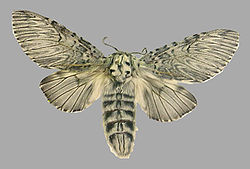Cerura vinula
Large -tailed ( Cerura vinula )
The Great -tailed ( Cerura vinula ) is a butterfly (moth ) from the family of the tooth Spinner ( Notodontidae ).
- 3.1 Flight times and caterpillars
- 3.2 food of the caterpillars
- 5.1 Notes and references
- 5.2 Literature
Features
The moths reach a wingspan of 58-75 millimeters, the males are slightly smaller. They have white or yellowish-gray forewings, marked with dark lines. At the outer edge of the wings, these lines form a plurality of wavy lines. The hind wings are lighter gray, with the females they are almost transparent. Also the body of animals is colored white and gray bears on the top of the abdomen black cross bands.
The caterpillars are about 80 mm long and have a very plump physique. They are bright light green color and have a black-brown, white -bordered back drawing that runs in the middle of the body triangle on the body side. Sometimes they have on the seventh segment a white bordered, round, red spot. Young caterpillars are completely black and have two head behind the ear-shaped buttons, old caterpillars are discolored dark brown just before pupation. The head is dark around it, the body is strikingly pink and the outside brightly colored. On the top of this ring there are two black eyes glow. The sternum pairs are striped black and light. The abdomen ends in a tail fork with two long, dark colored tips from which red threads can be everted.
Similar Species
- White -tailed ( Cerura erminea )
Occurrence
They come in all of Europe except in the far north, east to China frequently and widely used before and live in damp, sunny to partially shaded sites with stocks their food plants such as forest edges, gravel pits and water edges.
Way of life
The caterpillars have a remarkable defensive behavior. Pull the head into the first chest segment and stretch the enemy the red area around it and the apparent eyes meet. By drawing the caterpillar is also much thicker. In addition, they can out of the double tail at the end of each abdomen evaginate a long red hose that can perform trembling movements. If the bead is further irritated they can out of a gap at the bottom of the head formic acid, which is produced in a gland, about 30 centimeters wide splash.
Flight times and caterpillars
The nocturnal moths fly in one generation a year from late April to early July. The caterpillars are found from June to September.
Food of the caterpillars
The caterpillars feed on the leaves of young and not too high so quaking aspen (Populus tremula ), other poplar species of Sal - willow (Salix caprea ) and other willow species.
Development
The females lay their 1.5 millimeters wide, chocolate brown, hemispherical eggs usually in pairs, rarely individually on the top of the leaves from their food plants. The caterpillars usually pupate at the base of the stem to the cortex, in which they gnaw a shallow bowl. Sometimes you can find them on lying around in the leaf litter stumps of branches. They produce textile threads and the Nage chips a flat, egg-shaped, very firm and thick cocoon. This is perfectly camouflaged on the bark. During the rearing period can give the caterpillar sawdust as a substitute. The doll is thick and dark reddish brown. They wintered before the moth emerges in the spring. As the cocoon is solidly built, the moths must discard before breaking up a liquid that softens it.









